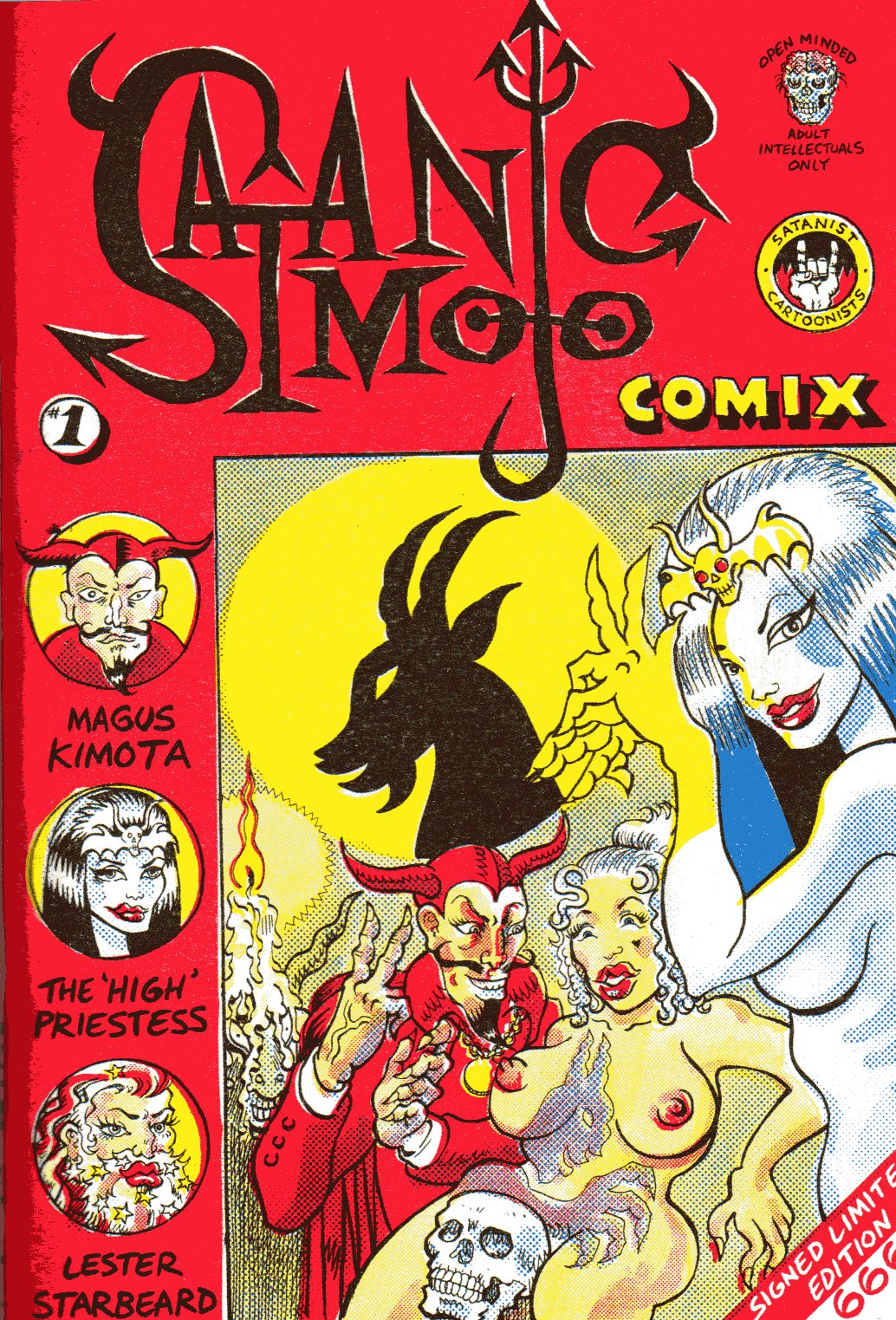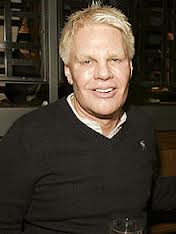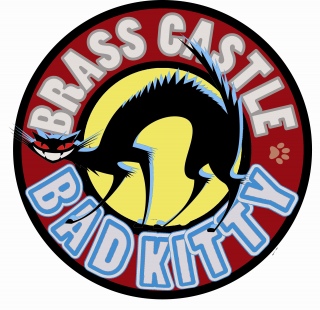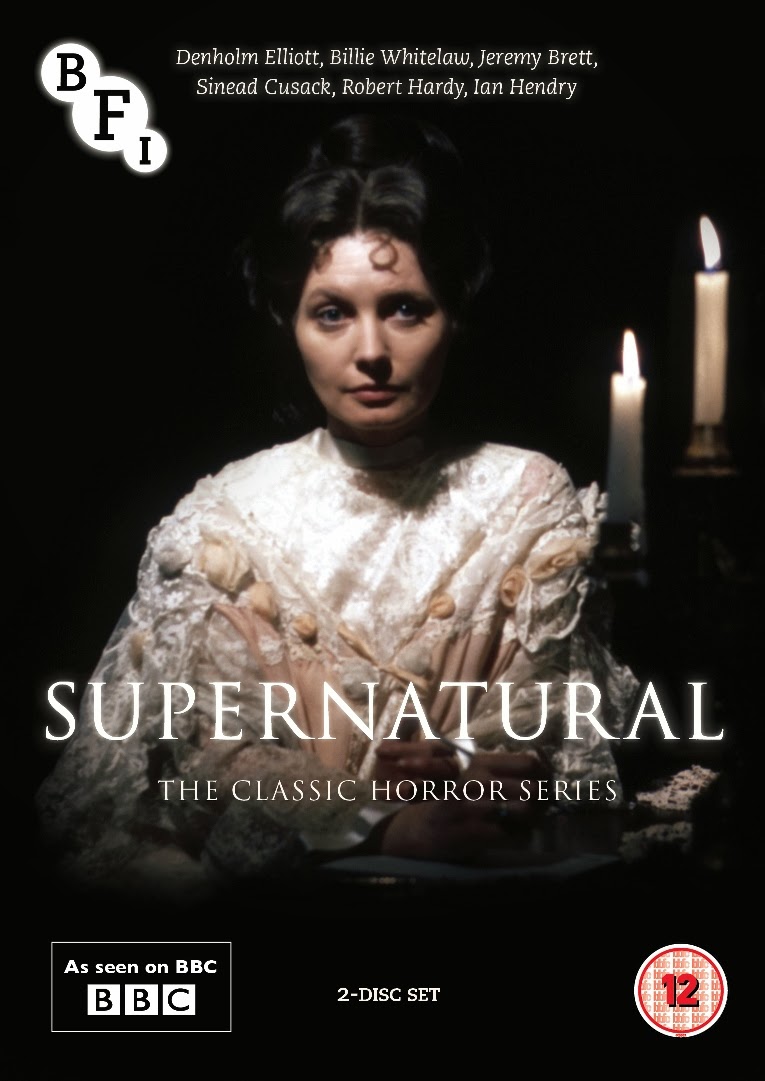
I put my guest reviewer’s hat on again for a brief sojourn at Brutal as Hell, taking in the recent DVD release of the BBC’s 1977 series Supernatural as part of the BFI’s excellent Gothic season. Contemplating the series also inspires me to meditate on the oft-overlooked relationship between the films and programmes we enjoy and the time that we first encounter them. To learn more, just click here dear reader…
To Hell and Back
A Trip Down Metal’s Memory Lane with Kev Bower of Hell
When Old Nick magazine approached me recently about penning another piece for them, as ever they were kind enough to offer me carte blanche on the subject of my contribution. I had no hesitation in proposing a feature on the metal act Hell. Both because I thought Hell’s infernal aesthetic chimed perfectly with Old Nick’s devilish tendencies, and also as few bands have excited me as much in recent years as Hell. However, circumstances conspired to throw a few spanners in the works – securing an interview with founder and guitarist Kev Bower proved elusive – so my Hell feature for Old Nick won’t be appearing until early in the new year.
But, as I had plenty to say about the band, and their new album Curse & Chapter has just come out, I thought I’d put this essay up on my site as something somewhere between a teaser and a sister piece to the forthcoming Old Nick feature. As this is my site, it also allowed me to address a few more personal perspectives that might not be so appropriate for a newsstand magazine. While the Old Nick article will be more about Hell and the relationship between Satanism – particularly LaVeyan Satanism – and music, in the next few hundred words here, I’ll be talking to Hell’s Kev Bower about the band’s history and his views ( and my own) on the relationship between metal and the media…
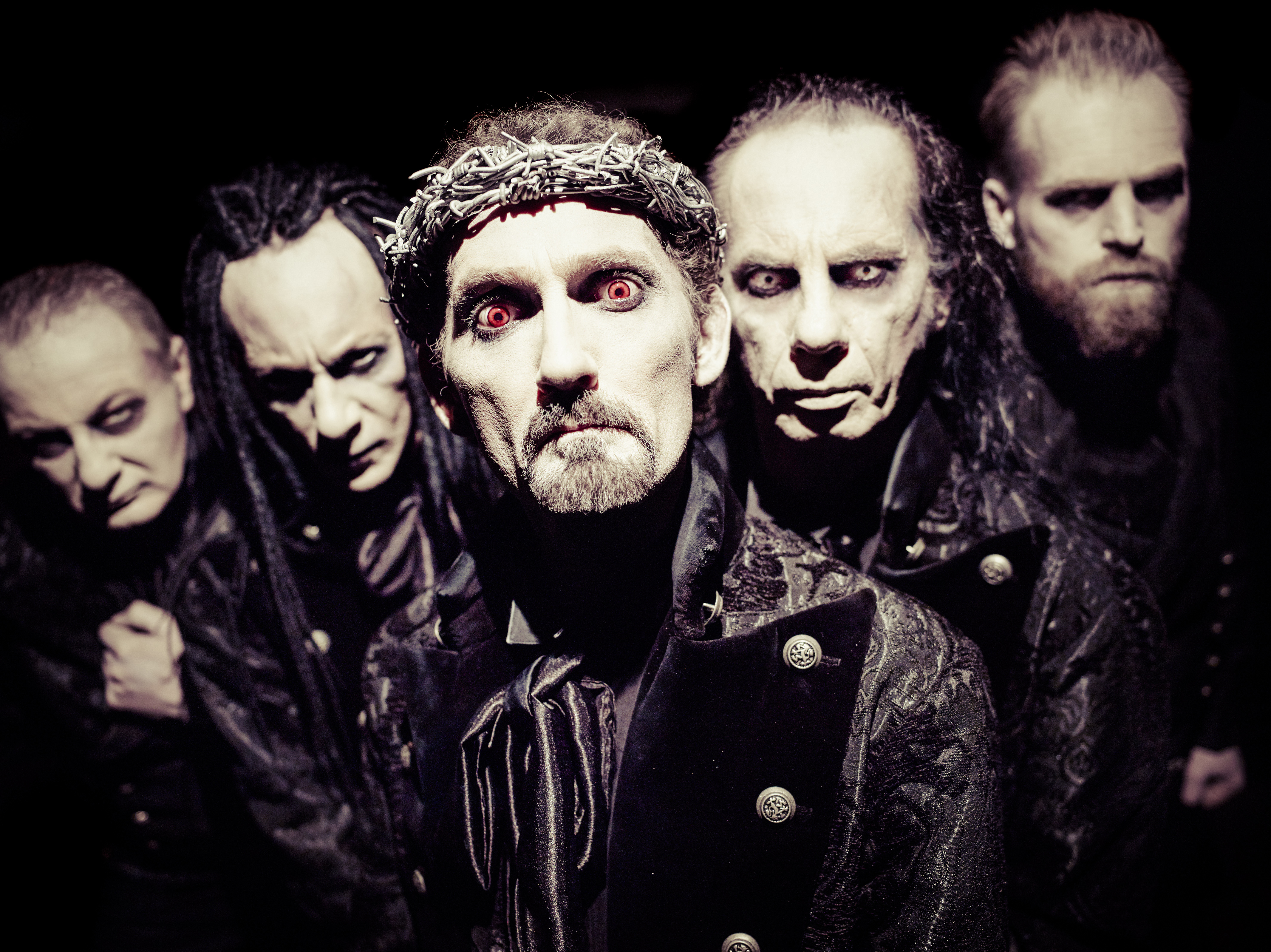
I first encountered Hell live in 2011 at the Bloodstock festival. They’d been given the graveyard slot, opening to a sea of grey, hungover faces as the opening act on the final day, playing under the full atmosphere-destroying glare of the midday sun. Yet Hell took it in their stride, winning over the crowd with an electric, powerfully assured blend of passion and professionalism. I’d been looking forward to the performance, and wasn’t disappointed. This reminded me of why I’d first become intoxicated by metal’s dark arts all those years ago, a pleasure that felt at once nostalgic and fresh. The music was sophisticated rather than merely complex, the lyrics authentically devilishly witty and acute. Vocalist David Bower delivered them with crisp, melodramatic aplomb, almost as if he were channelling Vincent Price from the camp Shakespearian horror classic Theatre of Blood.
Completing the picture was a wonderfully over-the-top, unholy stageshow, which was clearly an organic aspect of the band rather than an afterthought. “There’s really nobody doing the big theatrical productions that we’re doing – all of the fire, the pyrotechnics, the stilt-walking, the pulpit, the organ, and all the props. Apart from a few huge headline acts, nobody does it anymore,” observed Kev Bower when I raised the issue of the band’s shameless theatricality. “Obviously, if you go to an Iron Maiden show then you expect to see something on that dramatic scale. But where are the headline acts to replace bands like those guys? They’re all in their 50s or 60s and who’s coming through to replace them? It would be lovely to think it might be us.” It’s commendably ambitious, particularly for a band with such a turbulent history.
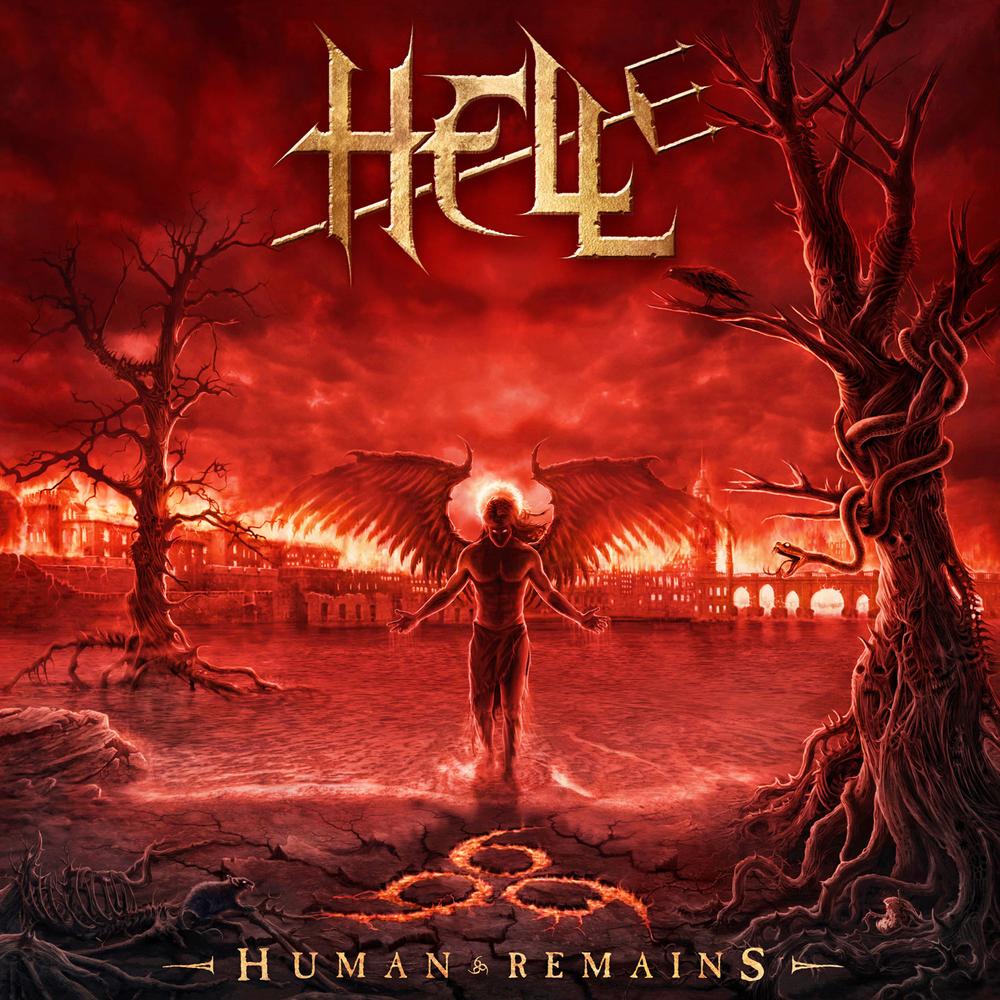
This 21st century Hell is the band’s second incarnation. They first formed in 1982, before tragedy brought an abrupt end to the band’s career five years later. “The original creative DNA of Hell consisted of myself and Dave Halliday, and it just kind of clicked, kind of happened”, explains Kev. “We were both very interested in the macabre and the occult and all that kind of stuff, and we both thought that it’d be really, really cool to develop something visual around that. Even though obviously people like Black Sabbath had been in that area for a long time, nobody had really developed a theatrical show in the way we were, even if it was on a budget of practically zero.
“What drove us down this route is the fact that the music that we do is often not instantly accessible. It’s not wave-your-arms-and-sing-along stuff – it’s quite technically complex – it can take two or three listens to get your head around it. We appreciated that we needed to keep people there watching us, and knew they’d stay as long as there was a lot of visual activity going on. At the moment everything we’re doing is on a modest scale – a lot of homemade props and a relatively small pyro system and all the rest of it. As the band grows in stature, as the fan base grows, as the size of the venues grow, and all the rest of it, so will the size of our production grow.”
Hell’s first incarnation came to an untimely end in 1987, when all of the preparations for their debut album came to naught, the band’s original vocalist/guitarist Dave Halliday taking his own life not long after. For obvious reasons they then decided to call it a day. But a cult following continued to revere the band’s memory, to wonder what might have been… Looking back, it’s clear Hell were light years ahead of the competition in terms of musical and lyrical intelligence and vision, that the dogged refusal of the domestic rock press to pay them any attention was not only a major injustice, but an indication of the cluelessness of the UK metal media of the era.
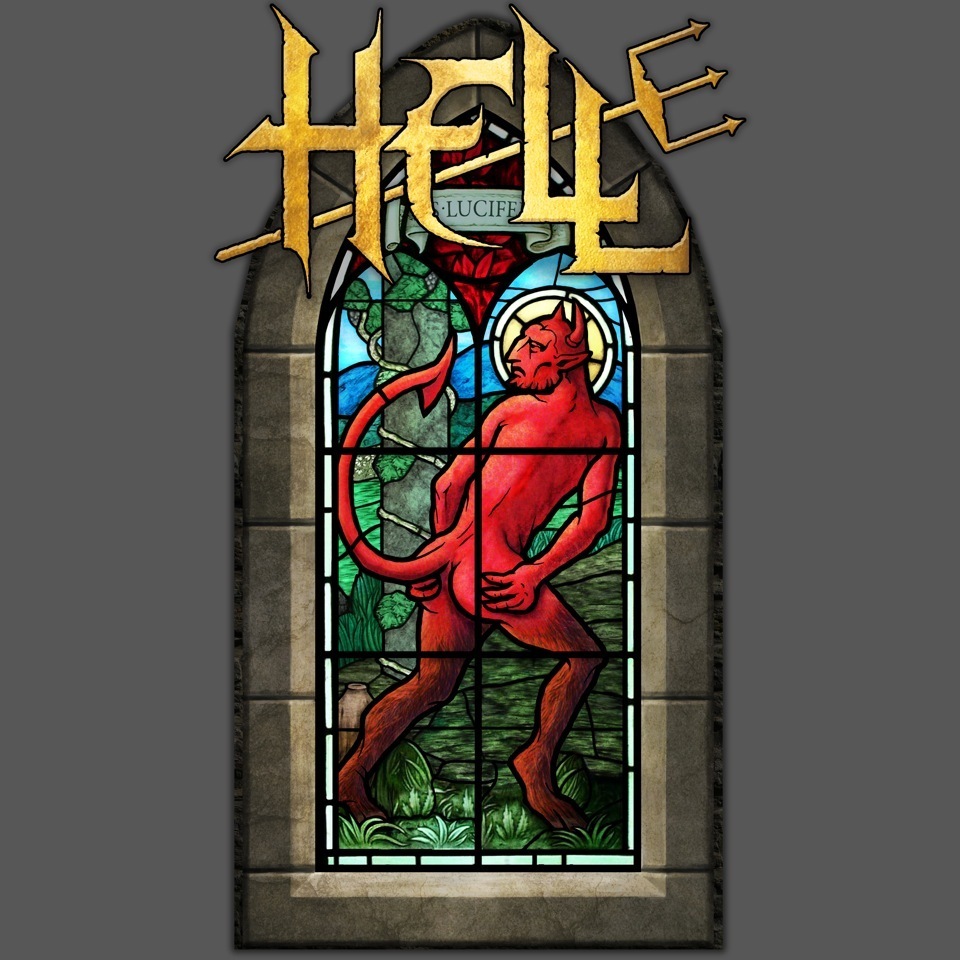
Unsurprisingly, Kev has his own views on why Hell were overlooked and under-appreciated during their 80s incarnation: “The professional reason is that we worked for five years, and then we got signed by this Belgian record label called Mausoleum, that went bankrupt two weeks before our album was due to be recorded. The artistic reason that we never made it first time around is that we were between a rock and a hard place. The whole New Wave of British Wave of Heavy Metal thing, the major bands – Iron Maiden, Saxon, Angelwitch – were all already established, and the whole movement was obviously in decline.
“Meanwhile”, he adds, “thousands of miles away, the whole Bay Area thrash revolution was starting to kick off, and we didn’t fit into that camp either. At the time the record labels in the UK were looking for bands with bigger melodies, bigger hair, bigger girl appeal, and obviously we didn’t fit into that category. We were in the wrong place at the wrong time.” Something that Kev doesn’t mention, but that I recall from being a teen metal fan at the time – confirmed by trawling through hundreds of old rock magazines while researching my first book, Lucifer Rising – was a dismissive antipathy to fantastic and allegorical themes, particularly Satanic imagery and lyrics, in the UK rock press. The fans might like it, but the hacks despised the nascent black metal scene.
The same might also be said for metal in general. I was surprised, when I started my own dubious career as a rock hack, by how many editors and fellow writers at the metal magazines clearly weren’t actual fans of the music. Rather, many saw a role in a hard rock title as a regrettable step towards finding employment covering a more ‘credible’ genre. If Hell suffered from this snobbery, they certainly weren’t the first (genre forefathers Black Sabbath were almost universally panned in the early days). Nor the last, though one of the next bands in the firing line of Britain’s bigoted rock press would ultimately prove a lifesaver for Hell.
As Kev mentioned, during the 80s the burgeoning thrash movement that was beginning its conquest of the international metal underground from America’s West Coast. Brit rock hacks were typically willing to give substantially more space and respect to these Stateside invaders – the dubious exoticism of hailing from across the Atlantic typically spared thrash bands the scorn reserved for Brit acts. Indeed one perverse side of the prejudice of the Brit rock press, of this widespread hostility to homegrown talent, was the ironic situation whereby the first time many of the neglected NWoBHM bands – pilloried at home – enjoyed any credibility was when they were acknowledged as influences by the American thrash bands happily hyped by the UK press. Meanwhile, Britain did have a thrash scene, though you’d hardly have known it thanks to the dogged indifference and bigotry of the domestic rock media.
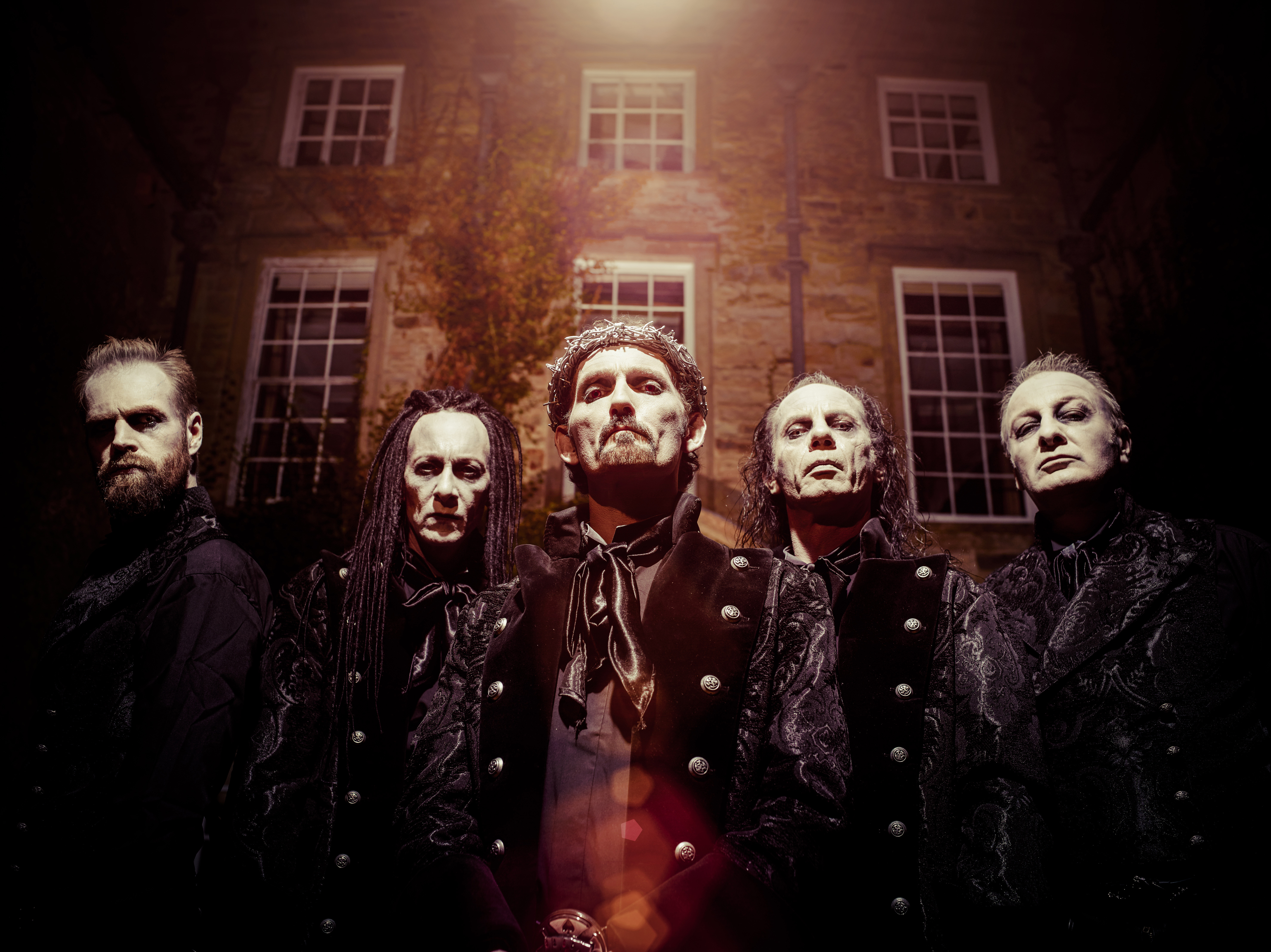
The Brit thrash band with arguably the brightest future, ultimately suffocated by a lack of homeland media coverage and label support, was Sabbat. Formed in 1985, the combination of Martin Walkyier’s sharp, clever lyrics and Andy Sneap’s intricate, innovative guitar-work initially earnt plaudits for Sabbat, but by 1991, under the pressures of trying to evolve in a vacuum, the band imploded. However, a curious continuity exists between Hell and Sabbat. Sneap and Walkyier were devoted Hell fans, the former even learning to play guitar from Hell’s ill-fated vocalist Dave Halliday. In the years following Sabbat’s collapse, Andy Sneap went onto become the best-respected UK genre record producer in the country, his name on the production credits of a host of landmark metal albums of the past 15 years, with a trio of Grammy nominations under his belt.
But he never forgot the band that first inspired him, and in 2008, Sneap set about orchestrating a reformation of Hell, in order to set the record straight by finally recording the band’s debut with the state-of-the-art studio facilities now at his disposal. Of course one vital member was now missing, and while Andy stepped in to take over Dave Halliday’s guitar parts, his former Sabbat bandmate Martin Walkyier was drafted in on vocal duties. But Walkyier’s singing proved too distinctively Walkyier and a new approach was required, which turned up in the sinuous shape of Kev’s brother, David Bowyer, a classically trained actor whose charismatic, melodramatic approach proved a perfect fit. In 2011, Human Remains, Hell’s debut album, was finally released, only 25 years behind schedule.
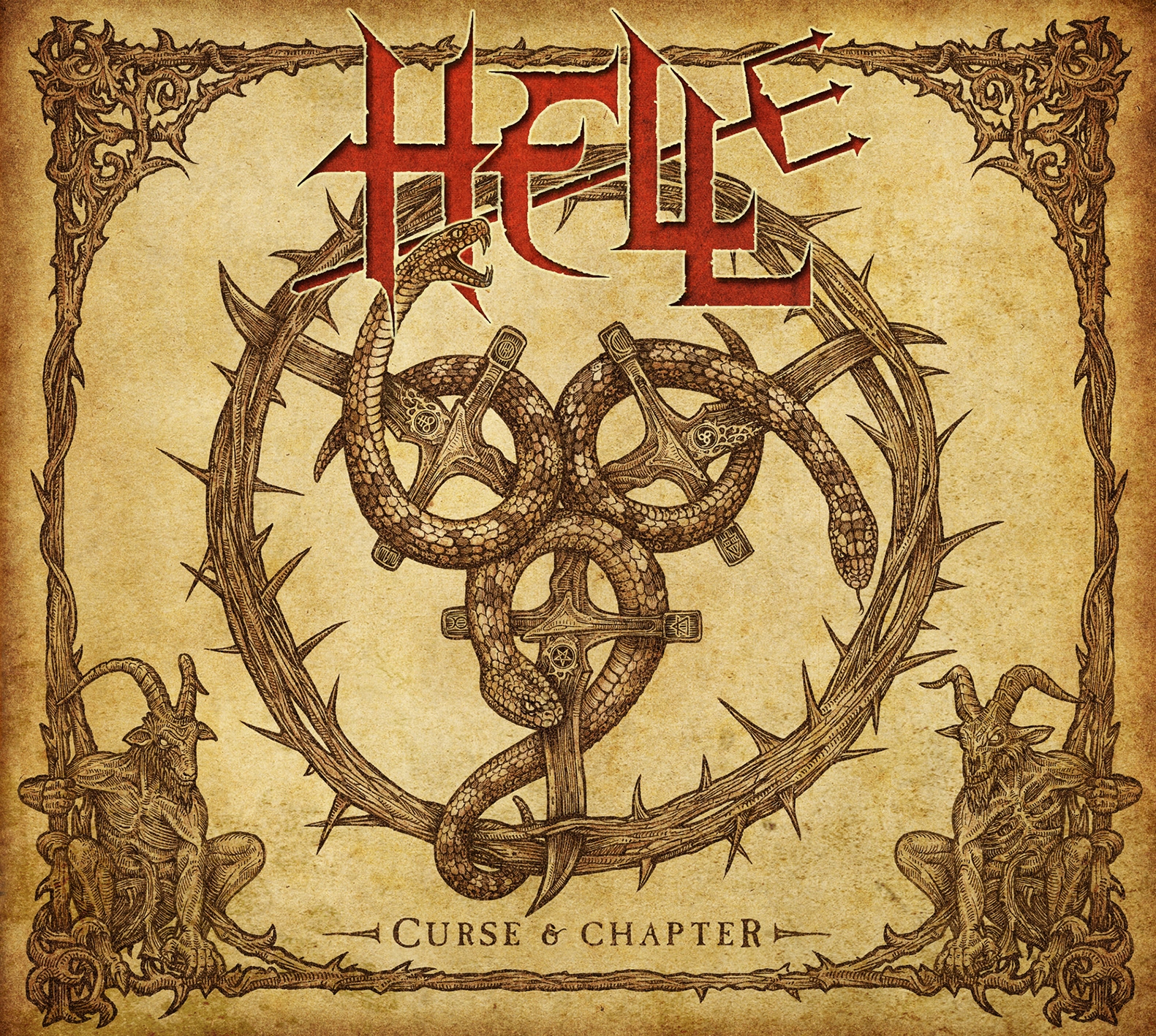
Now – with a happily generally more enlightened rock press – it received rave reviews. Two years on, and with a host of similarly enthusiastic live notices and fan awards under their belts, this left Hell on their difficult second album. “The issue for us, which is the same issue that faces any band that’ve produced a killer album, is that it’s so easy to fall at the second hurdle”, observes Kev. “Many debut albums contain all of the band’s best songs, all of their best ideas, all of the best riffs. But what happens next? The album comes out, it gets a fantastic reception, then they band tour it exhaustively for years, and then all of a sudden you get that phone call from the label saying, ‘Okay guys, we need the next album in six weeks please’. So many bands then hit the studio with nothing prepared, nothing written.
“With us, when the first album came out, I just didn’t stop, writing and rehearsing, to the extent that most of songs on this album were ready and demoed and good to go a year ago. It’s been quite a thought-provoking experience. You can’t afford to fuck up the second album.” For what it’s worth, I don’t think they have fucked up. Curse & Chapter’s another powerful work of intricate, epic, demonic art, replete with the intelligence, mischief and sly wickedness that made their debut an instant classic. I truly can’t wait to see it manifest fully on stage. In closing I mention to Kev why I was so keen to interview the band – that sense of remembering why I first got into the music I love. “We get that a lot”, he responds with a grin.
Old Nick Gets My Goat…
 Just time for a quick plug for Old Nick magazine’s horny Halloween special before heading off to Abertoir. Among the usual selection of sinful stories and pulchitrudinous pictorials is a feature by yours truly tracing the roots of the association between the Prince of Darkness and the humble goat. For further info and to lay your sweaty claws on your own copy, just click here.
Just time for a quick plug for Old Nick magazine’s horny Halloween special before heading off to Abertoir. Among the usual selection of sinful stories and pulchitrudinous pictorials is a feature by yours truly tracing the roots of the association between the Prince of Darkness and the humble goat. For further info and to lay your sweaty claws on your own copy, just click here.
The Return of Abertoir!…
 Details of the programme for the Abertoir horror festival have just been announced, with the event itself kicking off in under a month, and this year – the centenary of the birth of Hammer horror legend Peter Cushing – there is something of a Gothic flavour to affairs. Running between the 5th and 10th of November, the Welsh festival offers a peerless selection of vintage horror films and premieres of the latest celluloid chillers from around the world, alongside the best in horror theatre, music, and live presentations. (I conducted an interview with festival founder, the inimitable Master Gaz Bailey, last year, which you can check out here.) With passes for all six days priced at under sixty quid, it’s not only among the best horror fests in the UK, Abertoir’s also surely among the best value.
Details of the programme for the Abertoir horror festival have just been announced, with the event itself kicking off in under a month, and this year – the centenary of the birth of Hammer horror legend Peter Cushing – there is something of a Gothic flavour to affairs. Running between the 5th and 10th of November, the Welsh festival offers a peerless selection of vintage horror films and premieres of the latest celluloid chillers from around the world, alongside the best in horror theatre, music, and live presentations. (I conducted an interview with festival founder, the inimitable Master Gaz Bailey, last year, which you can check out here.) With passes for all six days priced at under sixty quid, it’s not only among the best horror fests in the UK, Abertoir’s also surely among the best value.

I’m both flattered and delighted that my favourite festival has invited me once more to deliver one of my infamous talks. This year’s address is entitled ‘Tell Me Strange Things’, and will be on Friday at 3pm. But I’ll be there for the duration, so anyone wishing to buy me a drink, chase me with a stick or whatever, please feel free to introduce yourselves. Meanwhile, for further information on the schedule, location, programme and anything else Abertoir related, click here to view the official site. Hope to see some of you there – it really is the most fun you can possibly have in a darkened room with a few dozen consenting adults!
The Count’s Counterfeit Castle…
Late last year, the nice people at Discovery TV were kind enough to fly me to Romania to appear in an episode of their excellent Bloody Tales of Europe series. Specifically the segment on Vlad the Impaler in the Tyrant episode, thanks to my 2010 book on Vlad, co-authored with true cime expert Paul Woods. When I first spoke to the Discovery researchers the one thing I recall saying when discussing possible locations was to avoid Castle Bran, as it has pretty much fuck all to do with either the historical Vlad or the fictional Count, but features in pretty much every documentary on the subject ever filmed. So, when they confirmed that they wanted to interview me on camera, where did they choose as the setting? You guessed it…
 To be fair, their is a tenuous Castle Bran connection, but we’ll get onto that in a minute. This wasn’t my first visit to Romania. I’d gone in 1997, the centenary of the publication of Bram Stoker’s novel Dracula, and wrote several articles on the connections – or absence thereof – between the fictional ghoul and the fifteenth century warlord. Romania’s relationship with the association between the Impaler and the pop culture Gothic icon was, and remains, highly ambivalent. On the one hand the original Vlad is a national hero, revered for resisting the Ottoman Empire against terrible odds, and the Western tendency to associate him with a camp, bloodsucking fiend is seen as deeply offensive and ignorant. On the other, Romania badly needs tourist dollars, and the fictional Count’s probably their biggest draw.
To be fair, their is a tenuous Castle Bran connection, but we’ll get onto that in a minute. This wasn’t my first visit to Romania. I’d gone in 1997, the centenary of the publication of Bram Stoker’s novel Dracula, and wrote several articles on the connections – or absence thereof – between the fictional ghoul and the fifteenth century warlord. Romania’s relationship with the association between the Impaler and the pop culture Gothic icon was, and remains, highly ambivalent. On the one hand the original Vlad is a national hero, revered for resisting the Ottoman Empire against terrible odds, and the Western tendency to associate him with a camp, bloodsucking fiend is seen as deeply offensive and ignorant. On the other, Romania badly needs tourist dollars, and the fictional Count’s probably their biggest draw.
This ambivalence is manifest in Castle Bran. The story I was told by locals when I first went was that the government had deliberately promoted Castle Bran as the original Castle Dracula because, while it looked the part, it had no connection to Vlad the Impaler. Hence tourists could be both kept happy and kept away from authentic sites associated with the Romanian hero. My research at the time also maintained that there was little to connect Bran with the fictional Dracula either, or, as a local tourism brochure put it, describing the fortress as ‘the trial and trap of Castle Bran, a fake Castle Dracula, set in the way to the genuine Castle, in order to stop the mobs from pestering the solitude of the Count.’ Of course things change. When I first went, the Communist regime had only been toppled by violent revolution a few years earlier, and the hangover of Ceausescu’s oppressive rule still felt stifling. There was surprisingly little Dracula tourist tat for sale in the Castle or Bran village below. The fortress was overrun with guides and curators, all trying to sell you endless tickets, permits and passes for opaque reasons in true, old school Communist style.

By the time I revisited Romania, Castle Bran had been reclaimed from the state by the Hapsburg aristocrats who had owned it before it was seized by the Communist government in 1948. These new owners – who now live in the USA I believe – had no qualms about associating Bran with both the Count and Vlad the Impaler. A market largely dedicated to tackly Dracula souvenirs had sprung up at the foot of the Castle. Not only were the new owners happy to have tourists associate their Castle with all things Dracula, they were distinctly unhappy about anyone suggesting otherwise. When I expressed scepticism about the numerous claims made in Castle Bran’s tourism literature, the Castle’s PR head honcho overheard and gave me a withering glare hissing something unfriendly sounding under his breath. The Discovery film crew ushered me to one side, as it became crystal clear that my presence was now a potential barrier to cordial relations between Castle staff and the film crew.
However, not wanting to leave too bad an impression, I later sent Bran the results of my research – or more accurately some research by another scholar which I had found – which showed that there just might be a link between Stoker’s vampire Count and Castle Bran, even if any link between Bran and the Impaler remains tenuous and elusive to say the least. In a 2008 article on ‘The Models for Castle Dracula in Stoker’s Sources on Transylvania’, Dr. Marius Mircea Crişan found that at least two of the books Bram Stoker consulted while researching his novel contain both pictures and descriptions of Bran that make it sound like the ideal lair for an undead aristocrat. ‘Anything more wild and romantic than the position of the castle cannot be conceived,’ reads one, ‘its accessories reminding the spectator of the nursery tales of his childhood – of Blue-beard and Giant Despair. Inside there are grim passages, trap-doors, and yawning depths, all bearing silent witness to the troublous times when these borders were invaded by the Tartar and the Turk.’

Of course we can’t know whether Castle Bran was truly the imaginative model for Castle Dracula – it seems plausible – though more likely there was no one single model, but that several places provided the inspiration for the Count’s fictional home. The same applies to the Count himself. I’ve been involved in more than one futile debate over how much the fictional Dracula owed to the historical original. Many, led by the formidable Dracula scholar Elizabeth Miller, insist the connection is largely literally nominal. I think there’s more to it than that. But this isn’t a debate with a definitive answer. Even were we able to quiz Bram Stoker on the matter he probably couldn’t fully resolve matters, because as every writer can attest, we often don’t realise where our best ideas come from. Notions ferment in our skulls, and then emerge on the page, but often lack any kind of return address.
Meanwhile, somebody’s posted the Tyrants episode of Bloody Tales of Europe on Youtube, and I’ve included a link below. You’ll be relieved to hear I feature fairly briefly, and that the programme overall is both entertaining and elightening. So far as I’m aware, the series has finished airing on TV, and the box-set which I assume will become available in due course, has yet to be marketed. When it is, I plan on securing a copy as it covers numerous fascinating subjects dear to my black little heart. I hope some of you will do the same, as I can attest to the wit, dedication and professionalism put into this project by the production crew behind it.
Satan Strips!…
I spoke to London artist Jason Atomic some time back about matters devilish (to read our discussion click here). In particular, we talked about his upcoming art project, which had its genesis in Jason’s discovery that his name was an anagram of ‘Satanic Mojo’. The phrase conjured up images of demonic sin from the swinging 60s and sinful 70s, eras that witnessed a resurgence of media interest in the occult. By coincidence, or otherwise (Jason has mischievously suggested the influence of Crowley’s upcoming Aeon of Horus) his interest is mirrored by a burgeoning trend for occult rock in the metal scene, where bands like Ghost and Electric Wizard have tried to invoke the lost spirit of psychedelic Satanism as first conjured by the likes of Coven and Black Widow over 40 years ago.
While music has a role to play in Jason’s Satanic Mojo project, for obvious reasons, his focus has been primarily visual. At the core is a myth he has created involving ‘black acid’ and imaginary evil cults, which the artist has endeavoured to weave into authentic occult lore of the hippie era. Much of the art was then produced to try and act as faux artefacts from this fabricated episode, sinister evidence of a secret Satanic affair that never really happened. Now most of the events – the gallery shows, the Super Satanic Saturday parties – are over, the principle relic left in the wake of Mr Atomic’s affair is the Satanic Mojo Comix, and Jason was kind enough to send me a copy, asking if I’d be willing to cast my eye over it and give my considered opinion as a lifelong collector of Satanic ephemera…
The comic is a collaboration between Mr Atomic and a number of fellow travellers from the comicbook and underground art worlds, namely Shaky Kane, Garry Leach, Paul Lyons, Dennis Franklin, Matt Valentine and Josh McAlear. As this lengthy cast list suggests, Satanic Mojo Comix contains a patchwork of styles, the unifying factor being a focus on the dark side of the psychedelic aesthetic, or at least as far as the format allows, as only the cover is in colour. The spelling ‘Comix’ is significant, as (in addition to creating a little confusion over plurals and singulars) it links the comic with the underground scene that enjoyed a golden age in the hippie era, the mispelling indicating both an anarchic attitude and X-rated subject matter. The Satanic Mojo Comix certainly follows suit, with its chaotic style, explicit content and determination to thumb its collective nose at ‘the man’.

As a straightforward comic, perhaps inevitably, Satanic Mojo Comix is only a mitigated success. While the stories are undeniably fun, there just isn’t enough of it when, for a similar price you could pick up a hefty full-colour graphic novel with far more pagination, depth and sophistication. Yet such a comment misses the point. Satanic Mojo Comix is endeavouring to replicate something from long before graphic novels raised the medium to the levels of literature, to an era when graphic comics usually implied the healthy dose of sex, drugs or gore found in the quasi-illicit world of underground comix. Fifty years ago, the depiction of such adult material, particularly in a medium traditionally associated with children, raised eyebrows (among other things).
Today, when every feasible form of perversion is only ever a mouse click away, transgressive comics – even transgressive Satanic comix – inevitably struggle to outrage or arouse modern readers and critics. Yet again, it’s probably pertinent to observe that Satanic Mojo Comix is more an artistic faux artefact than a conventional comic. I’ll elaborate on that shortly, but first let’s take a quick look at the contents. The spirit of underground comix legend Robert Crumb – whose famous ‘Keep on truckin’’ is given a Crowleyan twist in a Satanic Mojo pastiche – looms largest over proceedings. His lasciviously grotesque style – branded sexist, racist and pornographic by liberal critics – is woven throughout the publication.
The first story, Sex Slaves of Satan, suggests that other prominent figure of the 60s-70s underground comix movement, Gilbert Shelton. Though only if Shelton’s most popular creations, the Furry Freak Brothers, had taken a hash leaf from Charles Manson’s book and added occultism and murder to their zany drug-fuelled lifestyles. Other influences range from references to EC’s infamous horror comics of the 1950s, to subversive sexy satires of the blandly saccharine titles published by Harvey Comics, best known for Casper the Friendly Ghost. Perhaps the boldest story in Satanic Mojo Comix is the finale, where Walt Disney characters are depicted as devil-worshipping rapists – a ballsy move when Disney’s lawyers are reputed to be more ruthless and bloodthirsty than the most fanatical evil cultists.
Here, curiously enough, we find some overlap between Jason Atomic (responsible for the Disneyland After Dark strip) and arch-Satanist Anton LaVey, for both share obsessions with the USA’s foremost dream manufacturer, though perhaps for rather different reasons. LaVey liked Disney because of his bombastic, no-nonsense approach to art and his creation of ‘total environments’ and ‘artificial companions’ in the shape of the rides at his theme parks and the robots inhabiting them, going as far as to quietly suggest that Walt was a de facto Satanist, even if he didn’t realise it. By way of contrast, Jason Atomic seems to enjoy subverting the perfect, sterile world created by Disney, taking an impish delight in marrying the happy iconography of talking animals and lovesick princesses with images of deviant sexuality and sadistic violence. It’s crude but effective stuff, though I don’t know whether LaVey would’ve found it amusing or not…
Jason Atomic has expressed sincere admiration for Anton LaVey and his work on more than one occasion, though some might interpret the first strip in Satanic Mojo Comix as a disrespectful parody of the late San Francisco sorcerer. Certainly, Magus Kimota – the Satanist leader who meets a humiliatingly sticky end in the story – looks a lot like LaVey. But, bearing in mind Jason’s enthusiasm for wordplay, and the fact that Mr Atomic also looks a bit like LaVey, then there’s surely a large element of playful self-deprecation in the strip. The question of how serious the artist takes his Satanism is clearly an issue, and some diabolists will inevitably take his irreverent tone as evidence that Atomic’s merely a hipster tourist, a latecomer apt to abandon the field when his attention span is exceeded. Maybe. But LaVey was insistent that humour was central to Satanism, and contemptuous of the pious attitudes adopted by most supposed sorcerers. For what it’s worth, I think Jason gets the delicate balancing act between vaudevillian humour, lurid shock tactics and underlying serious intent about right.
The most obvious overlap between Atomic’s Comix and Anton LaVey and his concept of Satanism is in the emphasis on the importance of nostalgia. As already noted, Jason’s Satanic Mojo project reflects a burgeoning broader cultural fascination with late-60s-early-70s occult revival Satanism, manifest most obviously in the psychedelic vanguard of current cult heavy metal. LaVey’s Church of Satan was, of course, a product of that era, but LaVey’s also written at length on the power of nostalgia. Not just from a cultural or commercial perspective, but also as something possessing untapped psychological or even occult power. So, for example, LaVey suggested that cocooning yourself in an environment totally dedicated to a past era you find appealing or invigorating can protect you from the ravages of age. His most complete theory on the subject relates to Erotic Crystalisation Inertia (or ECIs) the idea that our sense of aesthetics – particularly erotic aesthetics – becomes fixed during our adolescence. As a keen Freudian LaVey believed this affected not just your sexual tastes and proclivities, but profoundly influenced almost every aspect of your psychological profile thereafter.
In LaVey’s case, his ECI was the underbelly of late-40s-50s America, in particular as encapsulated by the film noir aesthetic of classic Hollywood crime flicks of the era. He surrounded himself in décor and artefacts resonant of the era, dressed accordingly, chose cars that dovetailed with it. As did many dedicated members of the Church of Satan, and a certain noir chic came close to a uniform among many members. Which, for a long time, I felt missed the point. The noir shitck was LaVey’s ECI. To simply emulate it, when you weren’t even born when that visual world was alive, hardly follows what LaVey was suggesting. You’re not finding your own ECI – you’re borrowing someone else’s – which is only marginally better than submitting to the blizzard of arbitrary conformist nonsense of the herd. Yet, while I still feel that to a certain extent, these days I can’t help feeling that I’ve also missed the point somewhat.
To return (briefly) to the subject in hand – Jason Atomic’s Satanic Mojo Comix – he too is focusing on an era for which he surely has no direct recollection. Alongside a building wave of fringe artists in all media, who are starting to focus on the whole psychedelic Satanism aesthetic – effectively mythologising it – including, inevitably, the foundation of the Church of Satan. Yet, while I’m sufficiently ancient to just about remember some of this era firsthand (I was born the year LaVey founded the Church of Satan) surely Jason, and most of the members of the bands endeavouring to evoke the occult underground of almost half-a-century back, have only experienced it vicariously, through films, and magazines and lurid paperbacks discovered in dusty flea markets or the further reaches of eBay. Curiously, while many associate Anton LaVey with the hippie era – his Church was established at the height of movement in its San Francisco epicentre – he was vocal in his denunciation of the Flower Children as ‘psychedelic vermin’.

Any serious study of 60s-70s Satanism inevitably leads to a reference, albeit often in a derogatory sense, to the concept of decadence. Decadence is term far more often employed than understood. It’s occasionally been credited as a philosophy in certain unfashionable circles. Philosophy or not, decadence certainly represents a more intriguing perspective on modern life than the tiresome blizzard of ‘ism’s that currently dominate much popular debate. And in my opinion Anton LaVey certainly fits into the profile of a leading 20th century decadent, though not for the crass reasons usually associated with decadence by most casual commentators. The San Francisco Satanist was certainly no choirboy, but neither was LaVey just some louche lotus-eater: He was a prominent member of the Sexual Freedom League, and open about his sexual fetishes decades before it became fashionable, but part of his contempt for the hippies stemmed from their sanctification of LSD and marijuana as liberating sacraments.

Rather, it was LaVey’s fascination with an oft-overlooked aspect of decadence that marks him, in my opinion, as a leading 20th Century decadent, specifically the virtues of artificiality. While the leading French decadent pioneer and poet Charles Baudelaire was referring to narcotics in the title of his 1860 book Les Paradis artificiels, in a broader sense decadent philosophy championed artifice and illusion over nature and reality. In effect, they preached that reality was overrated, that life as experienced was always a poor second to its reflection in dreams, art, or idealised memory. Here we return to the concept of the artistic, even mystical significance of nostalgia as the world perfected. As found in the Den of Iniquity, in LaVey’s basement where he recreated a sleazy 50s speakeasy, complete with mannequin ‘customers’. Or indeed, those, like Jason Atomic who are trying to use art to recreate a version of psychedelic Satanism more stimulating and aesthetically perfect than it ever actually was in reality. Something actually made easier if, like so many of those now conjuring dark noir or hippie environments, you’ve never experienced the original firsthand.
It is tempting here to go on to speculate on the role of nostalgia in mainstream religion. How millennia of history allow creeds to propagate the most absurd fantasies as truth with the aid of rose-tinted spectacles rendered so thick by the passage of time that no hint of truth or light can possibly penetrate their lenses. But I began this rambling missive meaning to talk about Satanic Mojo Comix, and have wandered far from my original course. But isn’t this, perhaps, an indication of the publication’s success as a work of art – that it inspires speculation and debate? If you’re curious to look further into Jason’s Satanic Mojo project, then there is more here, while those eager to lay their hands on a copy of the numbered, limited edition (666 copies of course!) comic, should click here. On which note, I shall do what I wilt, then split…
Great Excitement as Man in Silly Hat Taken in for Questioning.
 So French police have arrested black metal musician and bell-end magnet Kristian ‘Varg’ Vikernes, and certain sections of the internet are aflame with animated debate.
So French police have arrested black metal musician and bell-end magnet Kristian ‘Varg’ Vikernes, and certain sections of the internet are aflame with animated debate.
Frankly, even if he dodges the terrorism charges, they’ll get Kristian on fashion crimes. Moving to the home of haute couture may prove a miscalculation for this Nordic knob-jockey. Having said which, I’d be willing to let him have the hat. Compared to previous headgear, it’s pretty chic, while if anybody can rock that ‘Bennie from Crossroads’ look, it’s Vikernes. But not the top. Pastel issues aside, it’s inside-fucking-out. News flash! Black metal mastermind in struggle to dress himself properly!
On a (comparatively) more serious note, I expect the French police are wondering the same thing I am: viz., how did this turd-puncher get into France in the first place? Norway’s not in the EU, so he will have gone through customs, where they presumably checked his records and then… okay, previous for pre-meditated murder and destroying ancient monuments, with extensive evidence of several loose screws and an ongoing campaign of incitement to racial hatred. Why didn’t you say so Monsieur Vikernes? Come on in and make yourself at home! Would your lovely wife care to join the local shooting club?…
On a more positive note, he’s unlikely to be enjoying the same pampering he did in Norwegian chokey courtesy of the Scandinavian liberalism he hates so much. The French police aren’t known for being over-fond of foreigners, or indeed weirdos, so in a cute irony, he’s likely to be falling down the stairs quite a lot at the hands of racist bigots.
Oh, and I’m owed an ‘I told you so’ on this. Vikernes is a textbook egocentric narcissist – a pompous, attention-seeking nutter in other words. The ‘black metal circle’ might’ve stayed at liberty a little longer had he been able to resist boasting about his crimes – and those of his former compatriots – to the press (this writer included). The minute the media’s attention began to wander, however, Kristian was bound to start thinking about kicking off again. I’ve seen a few people jokily connect this episode to bad reviews for his last album. Many a true word and all that…
Some folk have been debating his attitude to the ideologies of fellow Nordic mentalist Anders Breivik. This kind of misses the point in my opinion. Breivik was competition for his twisted version of the limelight, nothing more or less. Bloated egos like the one cultivated by Mr Vikernes tend to make a fuck of a mess when they finally burst. If there was an justice some of those morons and opportunists who’ve been merrily inflating his ego for fun and profit over the past couple of decades got caught in some of the resultant backblast. But they won’t.
A Texas Chainsaw Menu
Devilment on the Airwaves
 I was asked to appear on the NTS radio show Lucifer Over London, hosted by Alea Balzer, to talk about Satanism and such. For anybody curious, you can listen to it by clicking here (I’m in the 30/05/2013 episode).
I was asked to appear on the NTS radio show Lucifer Over London, hosted by Alea Balzer, to talk about Satanism and such. For anybody curious, you can listen to it by clicking here (I’m in the 30/05/2013 episode).
Ubercrappy and Fake
I’m pretty confident I wasn’t the only person whose reactions to the recent, widely-publicised, bullshit from Abercrombie & Fitch veered between a weary shrug and a desire to see the tapeworm in question flayed alive and rolled in fucking wasabi. For the benefit of those lucky enough to have thus far avoided this particular storm-in-a-bidet, A&F CEO Mike Jeffries has gone on record as stating that he ‘doesn’t want larger people shopping in his store, he wants thin and beautiful people.’ Furthermore, our style guru ‘doesn’t want his core customers to see people who aren’t as hot as them wearing his clothing.’
‘In every school there are the cool and popular kids, and then there are the not-so-cool kids,’ Mike explained. ‘Candidly, we go after the cool kids. We go after the attractive all-American kid with a great attitude and a lot of friends. A lot of people don’t belong, and they can’t belong. Are we exclusionary? Absolutely. Those companies that are in trouble are trying to target everybody: young, old, fat, skinny. But then you become totally vanilla. You don’t alienate anybody, but you don’t excite anybody, either.’ Fair enough there, Mr Jeffries, fair enough. I admire your candour and believe firmly in free speech, but…
Now where do we begin? Let’s try and avoid the cheap shots – such as the irony of being lectured on the subject of attractiveness by someone resembling a cross between a cheap, knock-off Stretch Armstrong and a badly battle-scarred butt-plug – and begin with a few fundamentals. Cool and popular are not the same thing Mike. Fact is, the demographic you’ve got in your sights there, with A&F’s range of crap couture, is popular-courtesy-of-money-courtesy-of-mom-and-dad. Might be cool. Seldom is. Because cool usually comes with rebellion, individualism, style – going beyond the norm – and Abercrombie and Fitch embody the norm folk of taste are desperate to transcend. At the risk of sounding patronising here, Mike, I don’t think you’ve really got your head round the basics.
Taking a quick virtual tour around the world of Abercrombie and Fitch courtesy of the Internet, the one thing I’m not getting is cool. Or attractive. Or hot. Or exciting. Or, above all, exclusionary. Fact is, Mike, I could order any garment from your corporate label at the click of a mouse, which I don’t think’s exactly exclusionary. Of course I wouldn’t make that click, because your designs are uniformly dorky, boring, ugly, and about as sexy as, well, you are. Checking out ‘this season’s hottest looks’ from A&F, to my untutored eye I’d probably nail the unifying aesthetic as thrift-store-preppie, or maybe trendy-trainee-accountant. There’s a worrying ubiquity of flip-flops here. Here’s some free advice Mike. Try and remember who it was told you flip-flops were cool, and fire them. They were taking the piss mate.
If one adjective leaps to mind while staring at your dreary designs, it is vanilla. However, I’m reluctant to use the term here personally. Not because the pejorative implications – lacklustre, ordinary, humdrum – don’t apply to Abercrombie & Fitch. Quite the contrary! But, because I just can’t get behind the routine slander of the noble vanilla pod which has become so regrettably commonplace nowadays. It’s a reference borrowed from the fetish scene to dismiss those who don’t indulge in unusual sexual practices, and I wouldn’t endorse it. I certainly don’t look down on fervent fetishists as sad deviants, but equally I don’t buy the mythology that extols them as elite sexplorers. A better culinary analogy might be between sushi and steak. While one offers exoticism and variety – a particular boon to jaded palates – but it’s difficult to beat the other for sheer satisfaction so long as it’s done right.
More importantly, perhaps, the use of vanilla as a synonym for dreary and commonplace seems to me a terrible gastronomic injustice. It’s the second most expensive spice, after saffron, extracted from an orchid found only in sultry tropical climes. And you’re telling me that’s less exotic than a fucking strawberry! On a more personal and practical level, one of my favourite beers is Bad Kitty, from Brass Castle, a brewery near to my hometown. It’s a porter, as dark, rich and thick as Kanye West – though considerably less tasteless and dull. What really makes the Bad Kitty is an infusion of vanilla that compliments the chocolaty flavours for a poky brew that’s anything but boring (they also donate 10p from every bottle to a charity that takes in abandoned animals rejected by other shelters).
All of which is rather veering substantially off the point. We were trying to help that nice Mr Jeffries who seems to have become horribly confused while pimping his tacky clothes. So, where’s he gone wrong?… Maybe brands just can’t be cool by definition. Cool’s an ineffable concept, but it has something to do with a mystical alchemy between a person’s appearance, their character, and their tastes. It’s not something you can buy, and most certainly not something you can sell, however ‘exclusionary’ you pretend to be. That’s perhaps what’s most nauseating about Mike’s self-important twaddle – the pathetic attempt to commodify one of the few aspects of life thus far not available for purchase in our increasingly vulgar culture.
 Buying a top-of-the-range Harley-Davidson won’t make a rich executive into an outlaw biker, whatever Harley-Davidson’s marketing people might have you believe. Similarly, buying a pair of Abercrombie & Fitch pants won’t make you ‘cool and popular’ or an ‘attractive all-American kid with a great attitude and a lot of friends.’ You’ll just be another sucker in another stupid pair of pants. Perhaps the facile world which Mike Jeffries inhabits doesn’t matter, but the increasing packaging of rebellion and cool does stick in the craw, however ineptly it is attempted. One of modern hip-hop’s most depressing contributions to modern culture is its – largely successful – attempt to wed street cred with crass capitalist excess and the ethos of the swaggering bully.
Buying a top-of-the-range Harley-Davidson won’t make a rich executive into an outlaw biker, whatever Harley-Davidson’s marketing people might have you believe. Similarly, buying a pair of Abercrombie & Fitch pants won’t make you ‘cool and popular’ or an ‘attractive all-American kid with a great attitude and a lot of friends.’ You’ll just be another sucker in another stupid pair of pants. Perhaps the facile world which Mike Jeffries inhabits doesn’t matter, but the increasing packaging of rebellion and cool does stick in the craw, however ineptly it is attempted. One of modern hip-hop’s most depressing contributions to modern culture is its – largely successful – attempt to wed street cred with crass capitalist excess and the ethos of the swaggering bully.
Perhaps that’s why the moronic statements from Mike Jeffries that triggered this rambling essay inspired such visceral reactions from some of us. Because, beneath the marketing bullshit is the unmistakable language of the bully. The kind of dysfunctional personality that can only measure their own happiness against the misery of others: who cannot appreciate the pleasure or beauty in anything beyond denying it to someone else. It’s often said that bullies are cowards. I’m not so sure. But the audience they require, the weaklings who stand behind them and cheer them on, most certainly are. And Abercrombie & Fitch make clothes for them, uniforms for drones who want to feel better than other people but don’t dare stand out. And that might be popular, but it ain’t cool.

